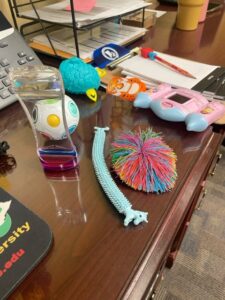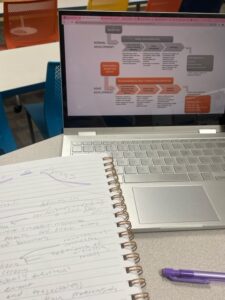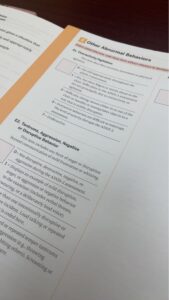Hello everyone! I hope that my blog post finds you well. My name is Ashlee Petranovich and I am currently in Murray, Kentucky attending Murray State University. While I am here on my internship I will be collaborating with four different programs that are focused on mental health, school safety, school psychology, and psychological assessments. These programs are indirectly or directly associated with the College of Education and Human Services at Murray State. The work that I will be completing in the next 7 weeks aligns with the following bullet points:
- Grant implementation experience through the MSU/WKEC Mental Health Providers Academy grant
- Counseling and assessment experience shadowing school psychology interns as they complete screening for and diagnosis of autism spectrum disorder in youth clients
- Assisting faculty with literature reviews on manuscripts and grants
- Website enhancements for KY School Safety
- Assisting the Center for Student Engagement and Success
- Sharing my perspective and knowledge
*Due to confidentiality and working with human subjects I am limited in what exactly it is that I can write about/post pictures of*
MONDAY, JUNE 12th
Today was another day at the clinic and unfortunately there was a no-show, meaning that the day was spent completing write-ups for reports and practicing administrating different tests onto others. Dr. Simons had both of his children come into the clinic and had them complete an ADOS-2 Mod 3 and a Woodcock Johnson Cognitive test. Since I haven’t seen a WJ test yet I decided to skip on observing the ADOS test and observe the WJ Cognitive test instead. The WJ test is a theory-based test that measures intellectual ability and broad and narrow cognitive abilities. It essentially examines a person’s ability to learn and reason. It is important to note that the test can be administered to persons from age 2 up to the age of 90. The WJ test tests nine sets of abilities such as: Reading/Writing, Visual-Spatial Thinking, Auditory Processing, Visual Matching, Comprehension/Knowledge, Long-Term Retrieval, Short-Term Memory, Processing Speed, Fluid Reasoning, and Quantitative Knowledge.
For the sake of keeping this blog as a blog post and not a book, I will focus on two of the tests found in the WJ-IV Cognitive test.
The first test that the examiners cover is Oral Vocabulary, which splits off into two subtests: Synonyms and Antonyms This test measures the knowledge of words and word meanings. The examiner begins with a sample so that the child can recognize the pattern of the words being said. The sample for this test was, “Another word for close is near” The examiner would then prompt the client by saying, “Tell me another word for big.” The client could then say words such as, “Huge, Large, Massive, etc”, this leaves the test to be rather open ended to varying answers. Since this test goes up to age 90, the words being asked progressively get more difficult/complex. The words spanned from “devour”, “conceal”, to “Illuminate”. After a long list of words, the examiner will shift to a different pattern for the child to answer to. This time, the client is attempting to find antonyms for words. The examiner will sample and say, “The opposite for yes is no” and will further go on to ask, “What is the opposite of up?” The client will then answer “no.” This test goes on until the examiner goes through the entire list of words. Similar to the synonym test, the antonym test will progressively get more complex with the words being asked. Ultimately, this first test measures Gc-VL (Lexical knowledge) which measures knowledge that can be expressed in words. The examiner is trying to note the depth of a person’s acquired knowledge and how expressive they can be with their knowledge.
If the client succeeds in a word, they receive a point. If the client does not correctly match a word, they score a zero.
The second test to the WJ-IV Cog test is the Number Series Test, which measures Quantitative Reasoning. The Number Series Test will include 4 boxes with three that have numbers inside of them. The last box is empty. The first three boxes will establish a relationship and a pattern between the numbers. The examiner will start with a sample:
2, 3, 4, _
“What belongs in the empty box(in our case, the underlined section)?” The client should recognize that when you count, the two comes first, then three, then four. In this sequence the expected number is 5.
This test goes on for the client as they are able to achieve the ceiling rules. In addition to this, the patterns get progressively harder. This test measures Gf-RQ (Quantitative Reasoning), the ability to reason with quantities and mathematical relations, and GF-I (Inductive Reasoning), the ability to draw conclusions from specific details.
After this test, I headed home and focused on some of the other side projects I needed to complete.
TUESDAY, JUNE 13TH
Today I had class and today’s lesson covered ADHD-(Attention Deficit/Hyperactivity Disorder)
Our warm-up today was a follow-up from last week’s lesson on Biological Basis of Behavior but also tied into today’s lesson. The warm-up was this:
You are conducting a record review for a student and note a current prescription for Gabapentin.
- Describe the pharmacodynamic action of Gabapentin
- Is it an antagonist or agonist? What does this mean?
- Which Neurotransmitter(s) does it affect?
- What’s the intended effect? Side effects?
I completed this warm-up and found that Gabapentin inhibits the release of excitatory neurotransmitters and reduces the excitability of nerve cells and allows for reduction of seizures and pain signals. Gabapentin is an agonist and antagonist depending on what site it binds to and handles the neurotransmitters GABA and Serotonin. We also spoke on what Gabapentin is doing on the neuron level and what is happening on the pre and post synaptic terminals.
After this we began to dive deeper on the history of ADHD, which has surprisingly been studied since the late 1700’s. The name of ADHD has had many different names throughout the years with various studies connected to it such as Minimal Brain Dysfunction, Hyperkinetic Reaction of Childhood, Attention Deficit Disorder, etc. While the characteristics of ADHD has been studied for a long time, it wasn’t until the 1970’s where the idea of heterotypic continuity emerged. Heterotypic continuity is an idea that states symptomology are present throughout the lifespan but change their expression throughout development. An example of this idea would be comparing a 6 year old and a 19 year old with ADHD. At age 6, the child- boy or girl- would possibly have excessive motor movement, struggle with blurting out, and trouble with sleeping. At age 17, the teenager is possibly now driving and is balancing a job. The 17 year old now possibly has more excessive risk taking abilities (speeding, shows up late to work), is able to regulate motor movement, and still has trouble with sleeping.
Later on, after discussing behavioral inhibition and executive functions, we spoke on Barkley’s ADHD Theoretical Framework. These models displayed the self-regulation and impaired self-regulation found in behavioral inhibition and behavioral inhibition deficits.
After this we spoke on the factors that go into ADHD along with the evidence based treatments that can be utilized for ADHD.
After my three-hour long class I had a meeting with the Partner and Connect grant over zoom and got to meet everyone formally there.
WEDNESDAY, JUNE 14TH
Today was the longest day I had at the clinic that went from 9:00AM-4:00PM as we worked with a case. This case handled with a child that was older than the age of 5 and younger than the age of 10. This child completed a WPPSI test along with an ADOS-2 test. These tests involved the child working with blocks to match the examiner’s model blocks, pointing to photos that displayed a specific emotion, identifying verbally what the picture is describing, engaging in free play, responding to name, etc. While I did observe the child while they played, I was mainly working with the parent and the interview process they had to go under. This interview was an emotionally hard one to process since there was a lot of trauma this family faced and there were a lot of reasons as to why the child was lacking in intellectual intelligence and struggled with delays of development. However, it made me feel very happy to know that the child is now growing intellectually and emotionally and has a very compassionate, empathetic heart. Hearing children giggle and have fun with the examiner is always so nice to see. After all of the interviews and observations I headed back to the school psych room and sat down with a graduate student and scored the CAARS test with her. I’m sure that this is a common feeling among people: but being able to keep up in a conversation that feels intimidating at first is a very rewarding thing. I was able to provide my input and reason with the scores I felt were appropriate for the child. I am feeling like I am one of the grad students!
Overall it was a great day and I am so grateful that I had the opportunity to really work with the graduate students. They are a very bright group of people who have been so kind to me.
THURSDAY, JUNE 15TH
Today was the last day observing at the clinic for this week. Jumping up in age, our client was a adolescent who took a ADOS-2 MOD 4 test along with a Woodcock-Johnson test while I was at the clinic. I have mentioned these tests before in previous blog posts and explained what they measure. I observed solely on the camera feed today and took notes on the general mannerisms that the adolescent would have, along with the responses that they would make. I took notes on the behavior the test taker should possess while testing, along with the dynamics of the test.
FRIDAY, JUNE 16TH
Today was orientation day for upcoming freshmen at MSU. I helped out student affairs and fulfilled their printing needs. It is honest work! It was nice to interact with some of the upcoming students and get to know them a little better. After this, we headed over to a local coffee shop and sat down for a little while before we had to head back to the school.
After I got home, I had 2 meetings online that were with the organizations I am a part of from Colorado. It was good to see everyone along with planning for some upcoming events. After this I called my best friend Karinna and checked in with her on how she has been, it ended up being a 3 hour long call! Makes up for being 1,000 miles apart.
The weekend was spent resting after the very busy week I just had! Overall, it was a great week with so much learning involved.
Grateful for this week and looking forward to next week!
——————————————————————————————————————–
Thank you for reading! See you next week.







Ashlee, I was on the edge of my seat reading this entire post! Is there a particular test that you find the most interesting? It sounds like you are having a very well-rounded experience and getting to interact with patients and their families which is super important! I will be looking out for your next blog post!
Sarah, I am so happy to hear that! You are so kind, thank you for that! At the very end of my internship, I want to rank all of the diagnostic tests for fun! So far I think that the ADOS-2 test is my favorite. It allows the patient to really engage in creative play and talk to the examiner. It isn’t all remembering patterns and mental puzzles! Thank you for reading!
There is no end to your talent. So very proud of you and all you are doing.
Love you.